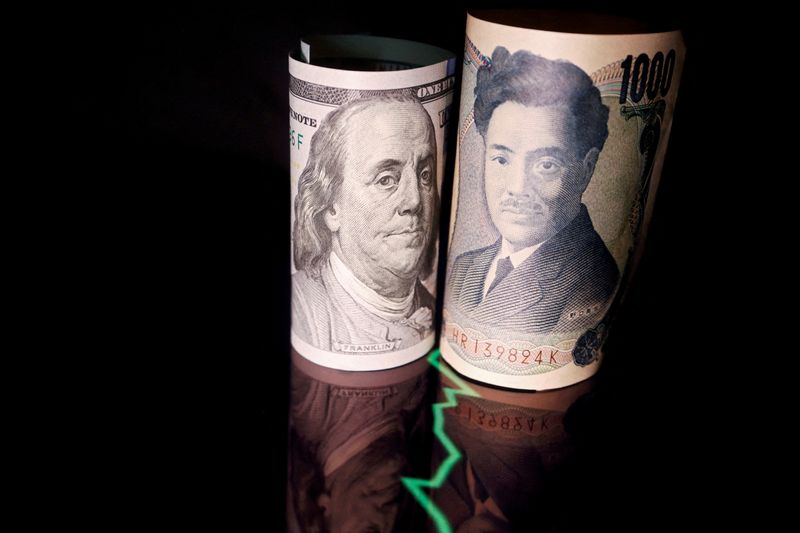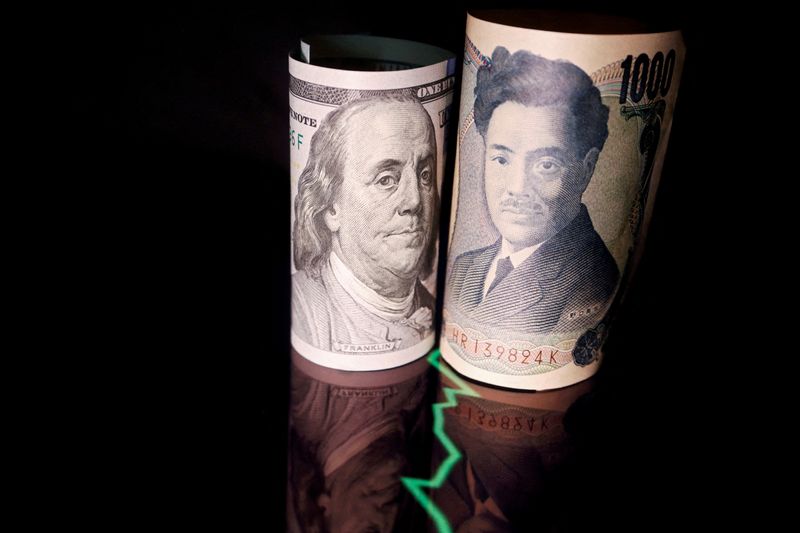Forex
Dollar slips, yen steady after Japanese finance minister comments


© Reuters. FILE PHOTO: Japanese yen and U.S. dollar banknotes are seen with a currency exchange rate graph in this illustration picture taken June 16, 2022. REUTERS/Florence Lo/Illustration/File Photo
By Karen Brettell
NEW YORK (Reuters) – The dollar dipped on Tuesday as traders waited on a fresh catalyst to give clues on Federal Reserve policy, while the yen was steady after Japan’s finance minister said that he would not rule out any measures to cope with the weakening currency.
Investors are grappling with whether the U.S. central bank will cut interest rates three times this year, as is currently expected, if inflation remains elevated and economic growth stays strong.
The briefly pared losses after data on Tuesday showed that orders for long-lasting U.S. manufactured goods increased more than expected in February, while business investment on equipment appeared to improve in the first quarter.
“The market is intensely searching for signs of cracks in the U.S. economy and they’re hard to find, and durable goods illustrates that again today,” said Adam Button, chief currency analyst at ForexLive in Toronto. “It’s a real wait and see market.”
Personal consumption expenditures (PCE) due on Friday is this week’s main economic catalyst. The U.S. core PCE price index is seen rising 0.3% in February, which would keep the annual pace at 2.8%.
Trading volumes on Friday may be light, however, with the U.S. stock and Treasuries markets closed for the Good Friday holiday.
The dollar index was last down 0.08% at 104.14, while the euro gained 0.12% to $1.0849.
The greenback may come under some pressure this week from month- and quarter-end portfolio rebalancing.
The yen was little changed on the day at 151.41 as verbal intervention by Japanese officials continued. It has weakened in the past week, despite the Bank of Japan’s (BOJ) ending eight years of negative interest rates.
Traders continue to focus on the still-stark interest rate differentials between Japan and the rest of the world, particularly the United States. A break past 151.94 per dollar, hit in October 2022, would take the Japanese currency to its weakest since 1990.
In 2022, Japanese authorities intervened in currency markets to support the yen.
Japanese Finance Minister Shunichi Suzuki said on Tuesday that “rapid currency moves are undesirable.” That came after Japan’s top currency diplomat Masato Kanda on Monday warned against speculators trying to sell off the yen.
“Dollar/yen is stuck around this 151.50 level. People want to go long/dollar yen because of carry returns, but if it goes to 152 or 153 they may get punished by the currency authorities so they don’t want to try,” said Yusuke Miyairi, currency strategist at Nomura.
The carry trade sees investors borrow in low yielding currencies to invest in higher yielding ones.
, which has also been on traders’ radars especially since its sudden sharp fall on Friday, gained slightly in the offshore market to 7.2492 per dollar after a firmer-than-expected fix from the People’s Bank of China.

 Forex3 years ago
Forex3 years agoForex Today: the dollar is gaining strength amid gloomy sentiment at the start of the Fed’s week

 Forex3 years ago
Forex3 years agoUnbiased review of Pocket Option broker

 Forex3 years ago
Forex3 years agoDollar to pound sterling exchange rate today: Pound plummeted to its lowest since 1985

 Forex3 years ago
Forex3 years agoHow is the Australian dollar doing today?

 Cryptocurrency3 years ago
Cryptocurrency3 years agoWhat happened in the crypto market – current events today

 World3 years ago
World3 years agoWhy are modern video games an art form?

 Commodities3 years ago
Commodities3 years agoCopper continues to fall in price on expectations of lower demand in China

 Economy3 years ago
Economy3 years agoCrude oil tankers double in price due to EU anti-Russian sanctions

























